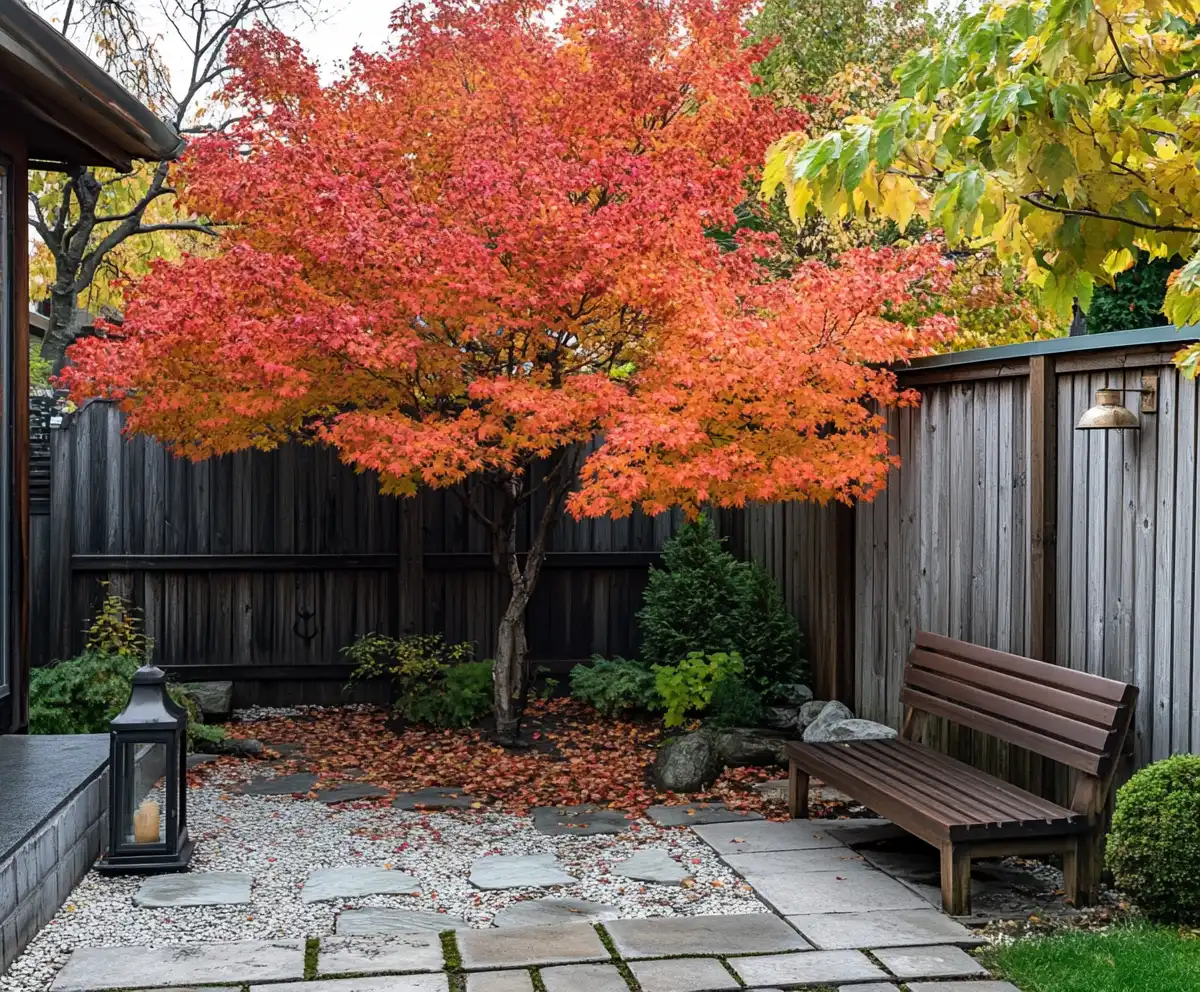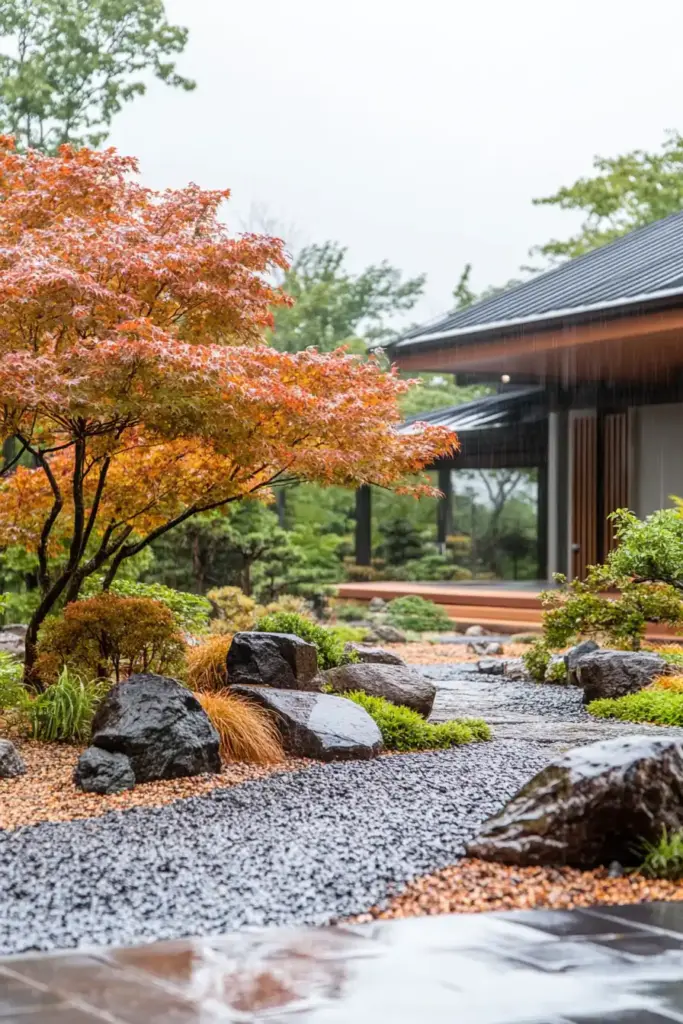Japanese maple garden is more than just a collection of trees—it’s a serene, artistic sanctuary where nature and design blend harmoniously. Known for their graceful forms and vibrant foliage, Japanese maples are a staple in many Japanese design garden ideas, offering elegance, color, and a peaceful ambiance throughout the seasons. Whether you’re working with a sprawling backyard flower garden or a small front yard, incorporating these trees can instantly transform your space into a tranquil retreat that reflects the spirit of Zen.
Their versatility makes them ideal for layering with ground covers, creating visual depth, or serving as dramatic focal points. In this article, we’ll explore 18+ inspiring Japanese maple garden ideas, from peaceful meditation spaces and fiery fall displays to vertical elements and bonsai artistry. Whether you’re a seasoned gardener or just starting out, these tips will help you craft a personal oasis that’s beautiful year-round.
🌿 Love gardening inspiration? Follow me on Pinterest for bold plant ideas, tips, and seasonal color!
Table of Contents
🍁 1. Create a Multi-Layered Look
One of the most visually captivating features you can introduce into a Japanese maple garden is a multi-layered planting design. This approach plays on depth, contrast, and elevation to give your outdoor space a rich, dynamic feel. By using various cultivars of Japanese maples—each with unique shapes, colors, and growth habits—you can create a tapestry of textures that keeps the eye engaged and the garden alive with interest year-round.
Start with tall, upright maples like Acer palmatum ‘Sango-kaku’ for height, and layer medium-sized varieties underneath such as Bloodgood or Osakazuki. Finish the design with low-growing, spreading types like Crimson Queen as ground-level highlights. This natural hierarchy mimics the layered aesthetics often found in traditional Japanese gardens.
Tips for Creating Layers:
- Mix leaf shapes and colors for contrast (laceleaf vs. palmate; red vs. green).
- Vary planting distances to allow light and air circulation.
- Add evergreen shrubs or mosses for year-round texture beneath the canopies.
Not only does this design approach enhance beauty, but it also supports biodiversity by creating micro-habitats. Whether you’re landscaping a hillside or a small backyard, layering Japanese maples will give your Japanese design garden ideas a lush, curated elegance.
🏞 2. Design an Inviting Pathway
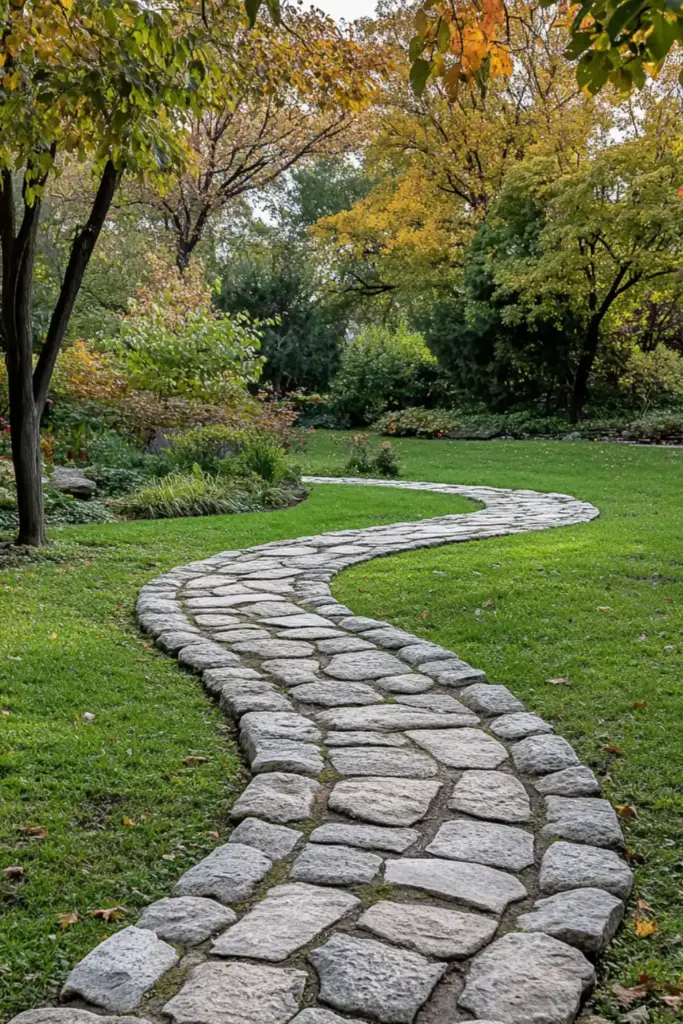
A thoughtfully designed pathway is more than just a way to move through your Japanese maple garden—it’s an experience in itself. In traditional Japanese design garden ideas, pathways are symbolic of life’s journey, encouraging mindfulness with every step. When framed by the elegant arches and flowing forms of Japanese maples, your garden path transforms into a peaceful, almost meditative space.
Stone, gravel, or wooden plank paths work beautifully alongside maples, offering a rustic contrast to their delicate foliage. Choose natural materials that age gracefully, such as weathered granite or slate, and allow moss or groundcovers like creeping thyme to soften the edges. As maples arch gently overhead, the path becomes dappled with shifting light—a signature feature of Japanese-style gardens.
Key Design Elements:
- Curved layouts invite exploration and create visual interest.
- Border the path with small maple saplings or hostas for texture.
- Incorporate lighting for safe, serene nighttime strolls.
If your garden space is limited, even a short winding trail can provide structure and elegance. It’s a simple yet powerful way to guide visitors through your Japanese maple garden while immersing them in a story told by trees, stones, and shadows.
🧘 3. Serene Meditation Space
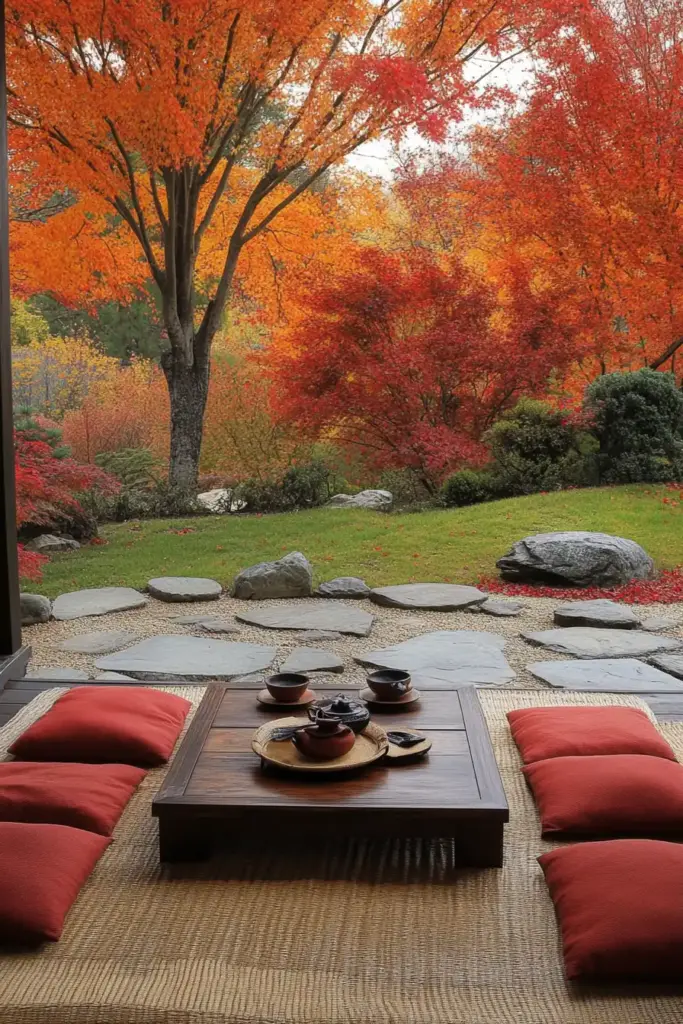
Creating a serene meditation area within your Japanese maple garden brings together the calming forces of nature and intentional design. Japanese gardens are renowned for their spiritual essence, often incorporating Zen elements that promote stillness and inner peace. By using Japanese maples as a natural backdrop, you can craft a tranquil zone perfect for yoga, mindfulness, or simple contemplation.
Choose a quiet corner of your garden and plant low, lacy varieties like Acer palmatum ‘Dissectum’ to soften the edges. Use smooth river stones or sand to define the meditation zone, and add bamboo screens or a simple wooden pergola for privacy. Incorporate textures like gravel, moss, or ornamental grasses to enhance the sensory experience without overwhelming the senses.
Ideas for a Calming Space:
- Add a bench or meditation mat under the shade of a maple canopy.
- Include subtle sound elements like a bamboo fountain or wind chimes.
- Use natural materials to keep the energy grounded and earthy.
A meditation area in your Japanese design garden doesn’t need to be large—it only needs to feel intentional and soothing. The graceful movement of maple leaves in the breeze and their seasonal color shifts can provide the perfect visual anchor for your daily escape.
💧 4. Add Tranquility with Water
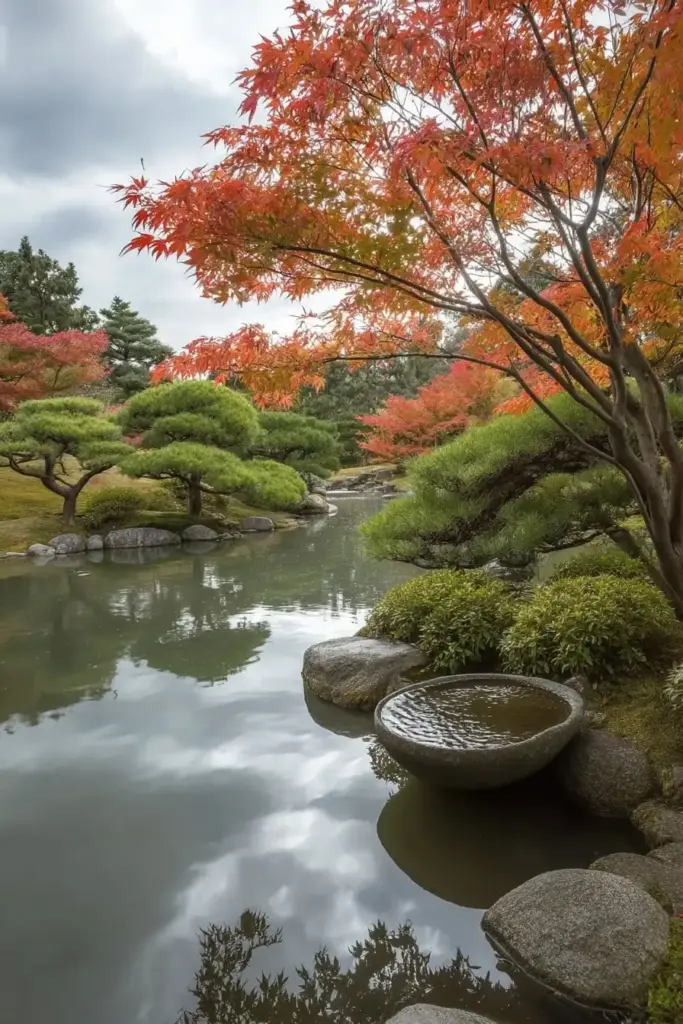
Water is one of the most calming elements you can add to a Japanese maple garden, and it’s a staple in many traditional Japanese design garden ideas. The gentle ripple of a stream or the soft trickle of a fountain brings sound, movement, and a sense of life to your outdoor space. When paired with the delicate foliage of Japanese maples, the result is a landscape of harmony and reflection.
Position maples near ponds, koi pools, or small waterfalls where their arching branches can lean over the water, casting graceful reflections. These mirrored images double the visual impact and amplify the garden’s sense of serenity. Even in small spaces, a container water feature or stone basin can evoke this calming effect when nestled among maples and mosses.
How to Incorporate Water Effectively:
- Choose quiet, recirculating water features to avoid overpowering the peaceful vibe.
- Surround the water element with smooth stones, ferns, or irises for natural framing.
- Ensure the maples’ root systems stay slightly elevated or well-drained to avoid saturation.
Water not only enhances the sensory richness of your garden, but it also attracts birds, dragonflies, and other wildlife, adding vitality to your peaceful retreat. The combination of water and maples creates a living canvas—one that reflects light, color, and time.
🔥 5. Fiery Focal Point
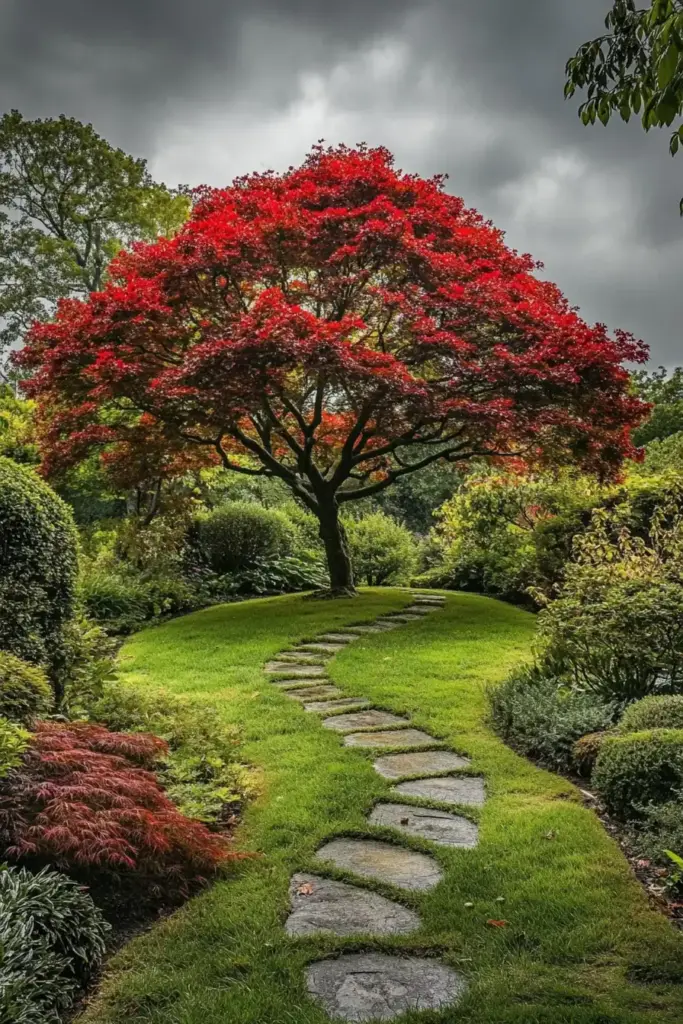
Every great landscape design benefits from a visual centerpiece—and in a Japanese maple garden, few things make a statement like the fiery hues of a mature maple in autumn. The bold reds, oranges, and golds create a natural focal point that draws the eye and anchors the surrounding space. Incorporating this feature into your Japanese design garden ideas can add drama and seasonal flair with minimal effort.
Plant your showstopper where it can be appreciated from multiple angles—near a patio, at the end of a path, or in the center of a courtyard. Cultivars like Acer palmatum ‘Osakazuki’ or Emperor I are known for their brilliant fall foliage and symmetrical branching, making them ideal for stand-alone planting.
Tips to Maximize Impact:
- Use contrasting backdrops like evergreens or dark fencing to enhance color vibrancy.
- Add a bench or boulder nearby to invite quiet admiration.
- Frame the view with ornamental grasses or low shrubs to elevate the focal point.
This single design move can infuse your Japanese maple garden with theatrical energy, especially in autumn when the landscape bursts into color. And while the fiery tones shine brightest in fall, the sculptural elegance of a maple provides visual interest year-round.
🏡 6. Create a Courtyard Oasis
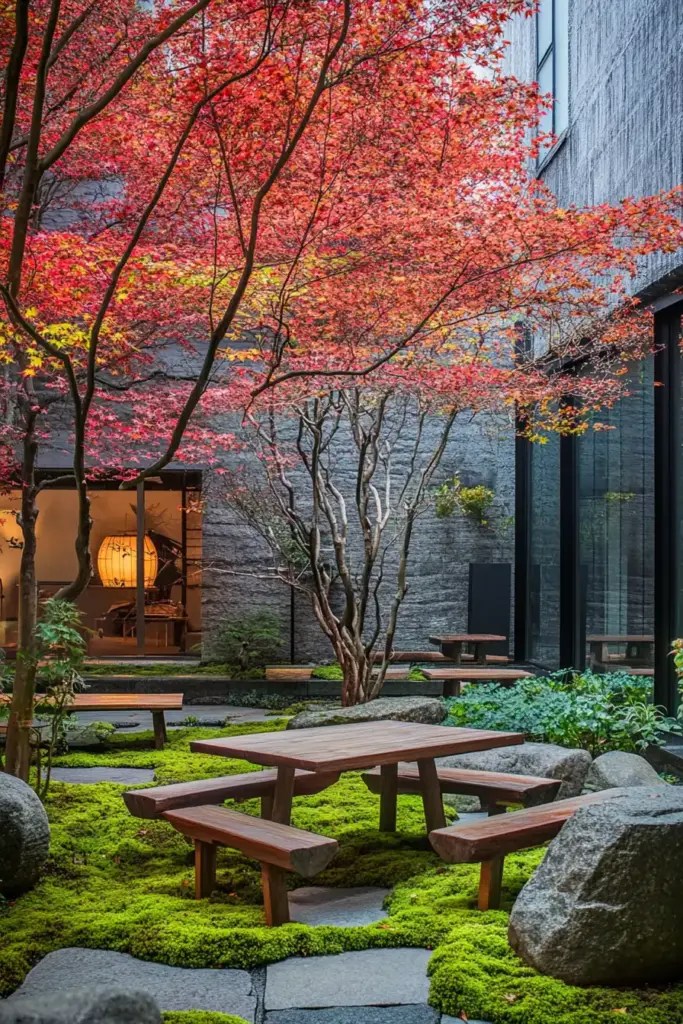
You don’t need a sprawling landscape to enjoy the benefits of a Japanese maple garden. Even a modest courtyard can become a peaceful sanctuary when designed with intention and a few choice maple trees. In fact, some of the most inspiring Japanese design garden ideas originate from compact urban spaces transformed through thoughtful placement and layering.
Japanese maples thrive in containers or small planting beds, making them perfect for enclosed areas. Their sculptural shapes and graceful foliage create a soft contrast to hardscapes like brick walls or concrete patios. Add a seating area, perhaps a wooden bench or a simple tea table, and you’ve got an inviting spot to enjoy morning light or quiet evenings.
Key Elements for Courtyard Tranquility:
- Use potted maples to keep the layout flexible and mobile.
- Incorporate vertical accents like bamboo screens or trellises to enhance privacy.
- Add texture with gravel, moss, or pebbles to evoke a traditional Japanese garden floor.
Even with limited square footage, a courtyard can become a lush extension of your home—a place where the elegance of maples adds soul and softness to your space. With just a few well-placed elements, your Japanese maple garden becomes an oasis of calm in the heart of your property.
📚 7. Craft an Intimate Garden Nook
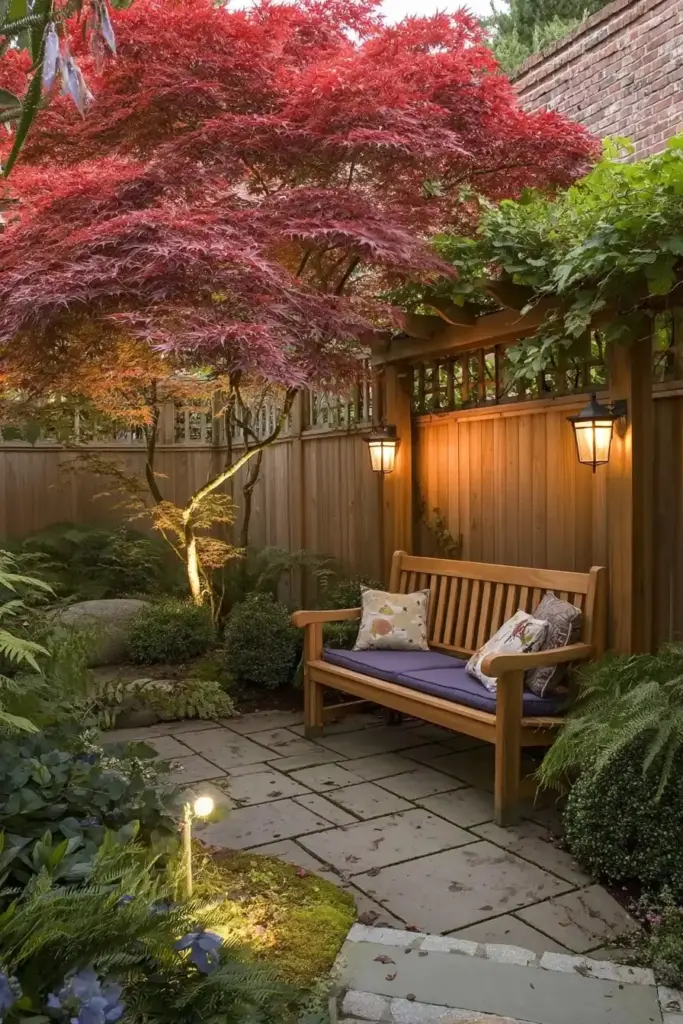
Incorporating a cozy nook into your Japanese maple garden invites quiet moments of solitude, reflection, and connection with nature. These small hideaways are a beloved feature in many Japanese design garden ideas, where the emphasis is often on simplicity, seclusion, and harmony with the surroundings.
Use gracefully arching maple trees to frame the space, creating a canopy that offers dappled light and shelter. Nestle a bench, a hammock, or a weathered stone seat beneath the foliage, and surround it with companion plants like hostas, ferns, or ornamental grasses. Consider adding a small side table for tea, books, or a bonsai centerpiece.
Ideas for a Perfect Garden Nook:
- Let Japanese maples act as living walls, shielding the nook with their branches.
- Use soft materials like moss carpets or smooth pebbles underfoot for a tactile, grounded feel.
- Introduce subtle accents like a bamboo water feature or solar lanterns for ambiance.
An intimate garden nook not only personalizes your space but also enhances the meditative quality of your Japanese maple garden. Whether it’s for morning journaling or evening unwinding, this quiet corner will become a cherished retreat.
🏯 8. Blend Traditional with Modern
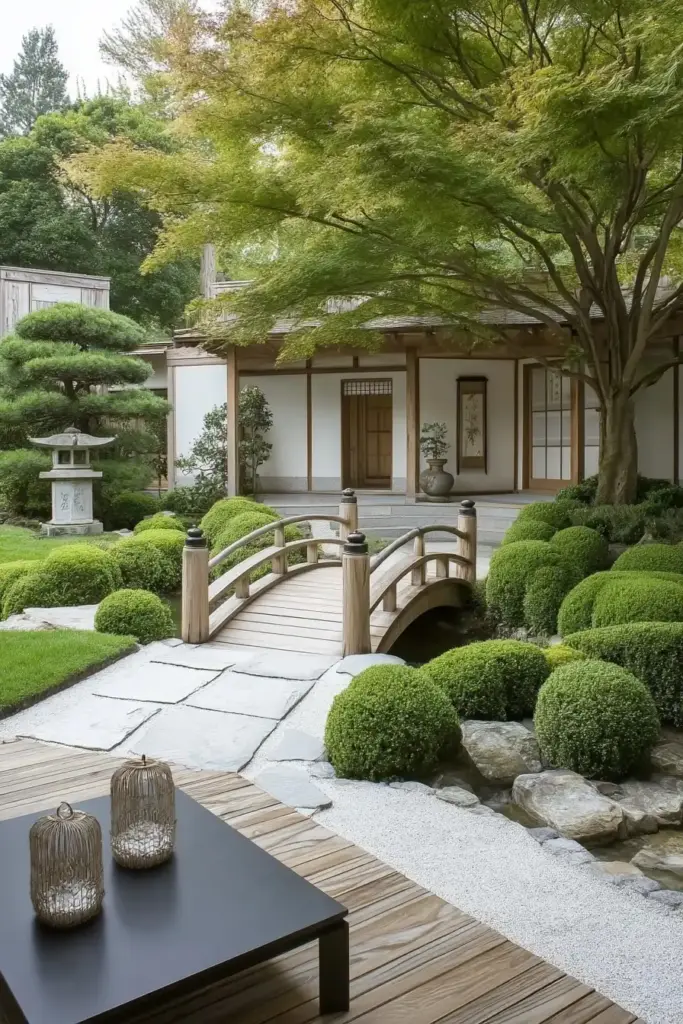
One of the most compelling qualities of a Japanese maple garden is its adaptability. These graceful trees are equally at home in time-honored Zen landscapes and sleek, contemporary settings. For gardeners who love the contrast of old and new, blending traditional and modern elements is one of the most exciting Japanese design garden ideas to explore.
Pair the organic curves of Japanese maples with clean architectural lines—think polished concrete patios, minimalist pergolas, or black steel planters. At the same time, incorporate classic Japanese touches like stone lanterns, bamboo accents, or water basins to root your garden in heritage. This juxtaposition creates visual balance and tells a story of timeless beauty evolving into the present.
Design Tips for the Best of Both Worlds:
- Use repetition and symmetry to unify diverse elements across the garden.
- Choose maples with striking structure, like Acer palmatum ‘Shishigashira’ or ‘Twombly’s Red Sentinel’.
- Blend materials—wood, stone, and metal—for tactile and visual contrast.
This fusion of styles doesn’t dilute the serenity of your space—it enhances it. A thoughtfully blended Japanese maple garden becomes a place where tradition is honored, and modern life finds room to breathe.
🎐 9. Accentuate with Garden Ornaments
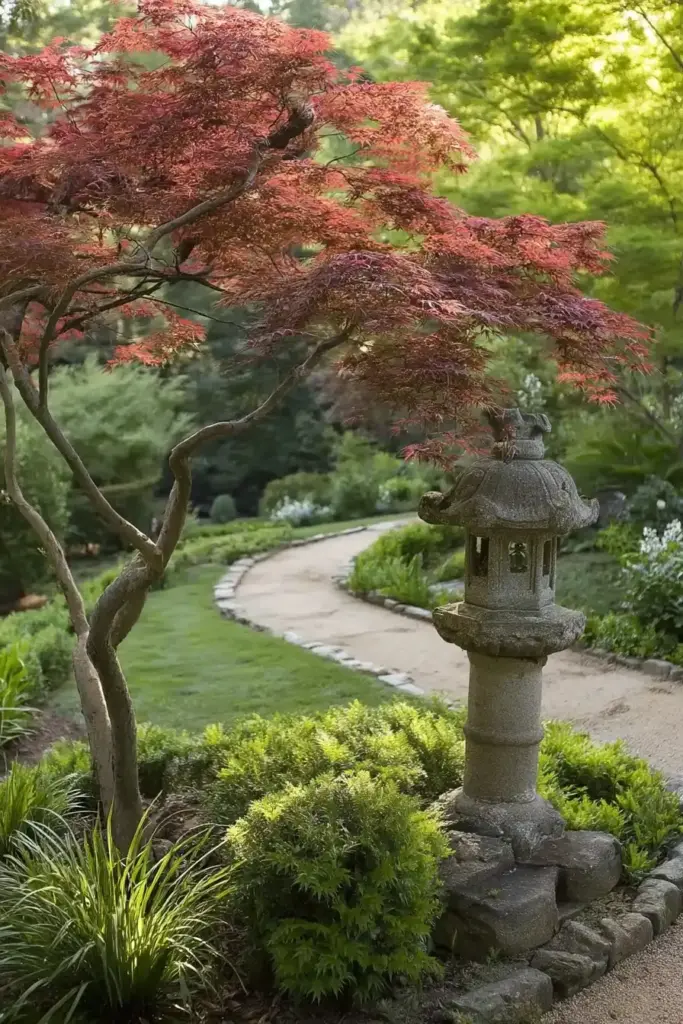
To elevate the elegance of your Japanese maple garden, consider the thoughtful addition of ornamental features. In many classic Japanese design garden ideas, simplicity is balanced with subtle symbolism—garden ornaments like lanterns, statues, and pagodas serve both decorative and spiritual purposes.
A well-placed stone lantern nestled beneath a maple canopy can become a glowing focal point at dusk. A small pagoda sculpture beside a winding path adds height and visual rhythm. Even a simple Buddha statue, tucked into a shaded corner, invites contemplation and harmony.
Best Practices for Ornament Placement:
- Keep it minimal—one or two key pieces per section is plenty.
- Let maples frame the ornament, not overshadow it.
- Choose natural or weathered materials like granite, wood, or ceramic to blend with the landscape.
Ornaments should feel like an extension of the natural world, not an interruption. When curated mindfully, these elements bring depth, cultural richness, and quiet character to your Japanese maple garden, reinforcing its sense of story and place.
🚪 10. Elevate Your Entryway
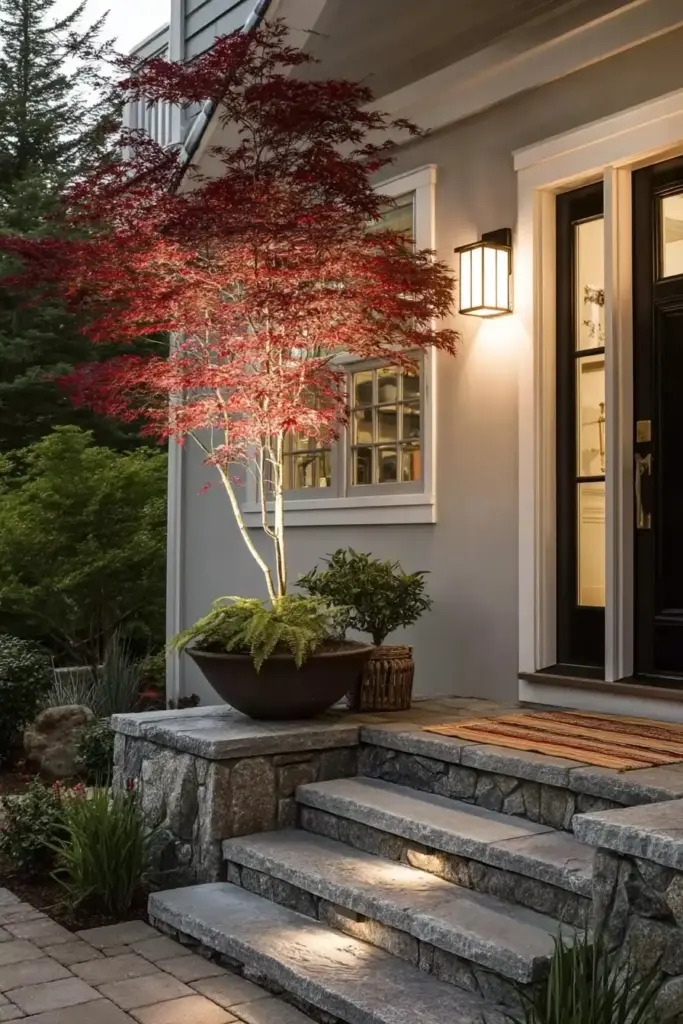
Your front entrance sets the tone for your entire home—and incorporating a Japanese maple garden at your entryway creates a welcoming first impression that radiates warmth, elegance, and intentionality. In many Japanese design garden ideas, entry points are treated as transitions into sacred or peaceful space. What better way to symbolize that shift than with the graceful form of a Japanese maple?
Planting a small, well-shaped maple near your doorway adds organic beauty and seasonal interest. In spring and fall, the vibrant foliage provides a burst of color, while in winter, its sculptural branches create visual drama even without leaves. Flank the entrance with matching containers or frame the path with smaller companion plants for symmetry and softness.
Entryway Enhancement Tips:
- Choose compact or weeping varieties like Acer palmatum ‘Tamukeyama’ for tight spaces.
- Use path lighting to spotlight your maple and guide visitors with subtle elegance.
- Coordinate planter materials (stone, ceramic, wood) with your home’s architecture for cohesion.
A well-placed maple at the entrance isn’t just beautiful—it tells your guests they’re entering a home that values serenity, beauty, and thoughtful design. It’s one of the simplest ways to make your Japanese maple garden feel both personal and welcoming.
🎨 11. Embrace the Beauty of Contrasts
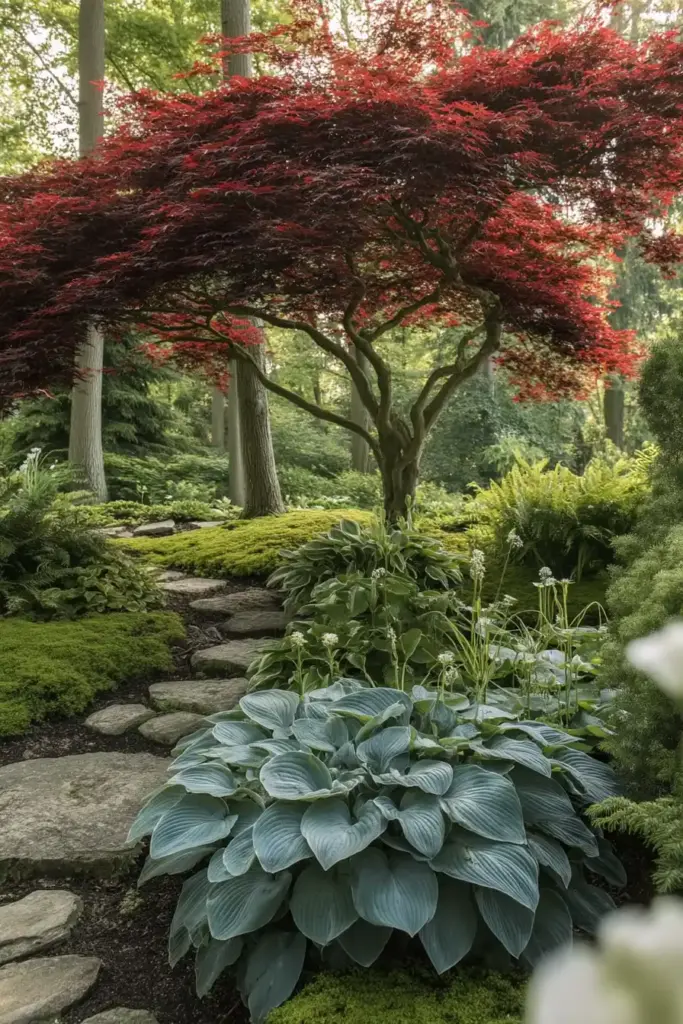
One of the hallmarks of a well-designed Japanese maple garden is the balance between bold and subtle, color and calm, structure and softness. Contrasts are essential in Japanese design garden ideas, as they create visual interest while preserving harmony. Japanese maples, with their vivid foliage and sculptural form, offer the perfect anchor for this dynamic interplay.
Pair your maples with plants that offer textural or color contrast—lush green hostas, feathery ferns, or silvery ground covers like lamb’s ear. The combination of finely cut maple leaves and broad, smooth foliage from companion plants creates depth and dimension, even in small spaces.
Smart Ways to Use Contrast:
- Color contrast: Red-leafed maples with green hostas or pale ornamental grasses.
- Texture contrast: Laceleaf maples next to bold, round-leaf plants for visual rhythm.
- Light and shadow: Use lighting or dappled sun to highlight differences in shape and tone.
By intentionally designing with contrast, you ensure that every element in your Japanese maple garden contributes to a balanced whole. It’s a subtle yet powerful way to create a space that feels both energized and serene.
📏 12. Embrace Vertical Gardening
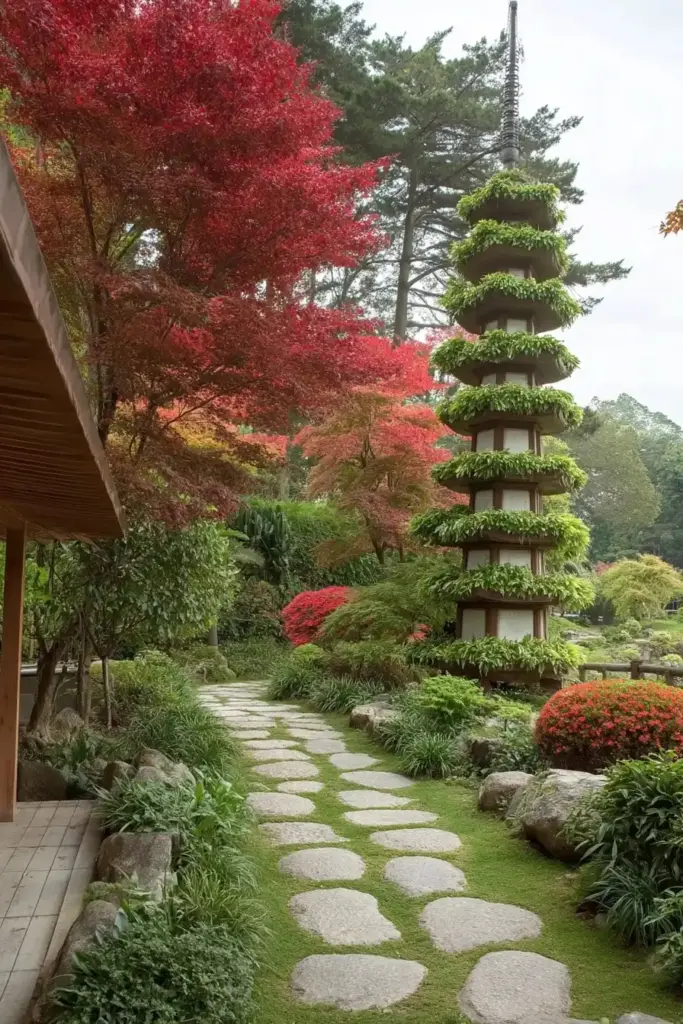
Verticality is often overlooked in small spaces, but it’s a secret weapon in landscape design—especially in a Japanese maple garden. Many traditional Japanese design garden ideas use vertical elements to draw the eye upward, create layers, and give even compact areas a sense of grandeur.
Japanese maples are ideal for this approach. Tall, upright varieties like Acer palmatum ‘Seiryu’ or Acer japonicum provide height without overwhelming the space. Position them near fences, walls, or garden screens to soften hard lines while adding structure. You can also incorporate vertical supports like bamboo trellises or climbing plant structures to complement the height of your trees.
Vertical Gardening Tips:
- Choose slender, upright cultivars for a narrow but dramatic effect.
- Use tiered planting to create a skyline of foliage—maples, shrubs, then groundcovers.
- Frame key views (like a doorway or sculpture) using vertical elements as natural guides.
Embracing height brings depth and flow to your Japanese maple garden, making the space feel more immersive and architecturally balanced. It’s a design strategy that turns even flat yards into visually dynamic retreats.
🌙 13. Light Up the Night
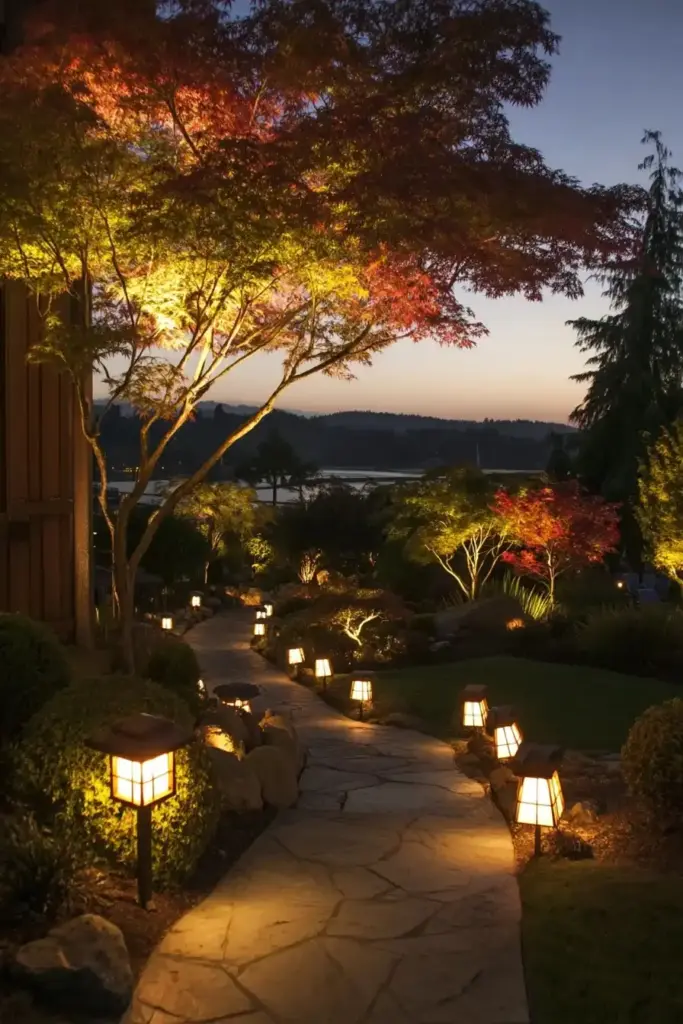
A Japanese maple garden doesn’t lose its beauty after sunset—in fact, with thoughtful lighting, it can become even more enchanting. Illuminating maples and surrounding elements is one of the most impactful Japanese design garden ideas for extending the enjoyment of your space into the evening hours.
Use soft, ambient lighting to highlight the elegant branching patterns and colorful foliage of your Japanese maples. Uplighting from ground-level fixtures creates dramatic silhouettes, while low path lights can guide guests gently through the garden. Avoid harsh, bright bulbs—subtlety is key to preserving the peaceful atmosphere.
Evening Lighting Ideas:
- LED uplights to cast shadows and enhance trunk texture.
- Solar lanterns for eco-friendly, flickering ambiance.
- String lights or fairy lights draped along branches for a magical canopy effect.
Thoughtful lighting doesn’t just beautify your Japanese maple garden—it makes it safer, more functional, and irresistibly atmospheric after dark. Whether you’re enjoying a quiet evening outdoors or hosting friends, the right illumination brings your garden to life at night.
🎨 14. Design a Colorful Border
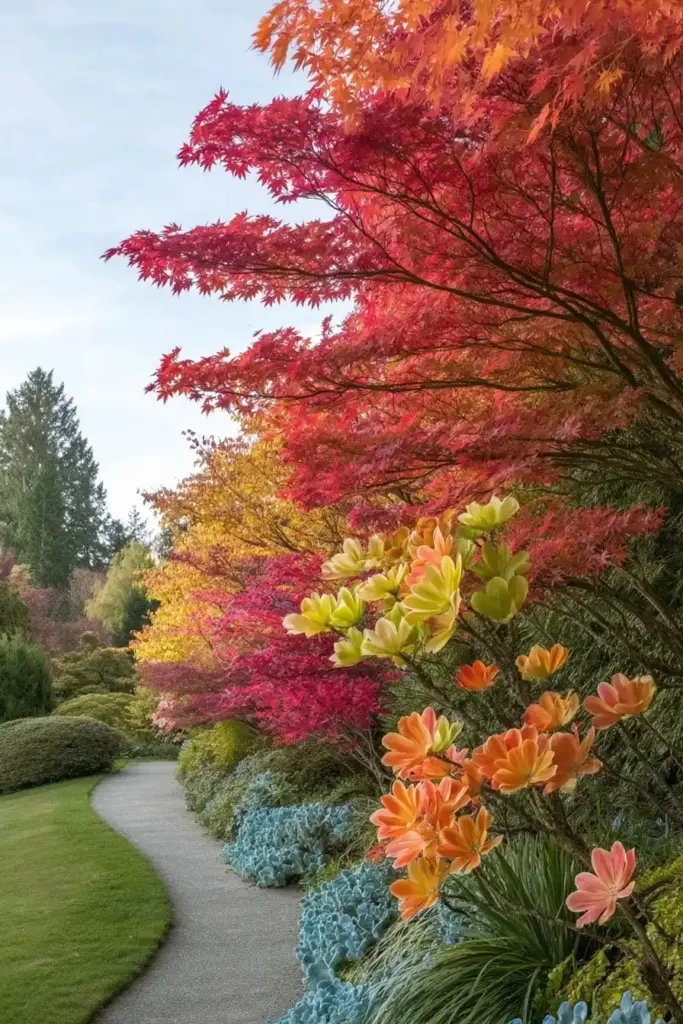
A vibrant border can beautifully frame your Japanese maple garden, giving it a finished, cohesive look. Among the most practical and visually rewarding Japanese design garden ideas, this technique uses Japanese maples as living edges that change with the seasons—adding bursts of red, orange, and green that evolve throughout the year.
Planting smaller or dwarf maple varieties along pathways, fences, or garden beds can create a rhythmic, colorful perimeter. Complement these with low-growing companions like moss, heucheras, or ornamental grasses to fill gaps and soften the overall look. The contrast in color and form between the maples and underplantings adds depth while keeping the border visually cohesive.
Colorful Border Design Tips:
- Use maples with staggered foliage colors for multi-season interest.
- Alternate textures—combine laceleaf maples with bold-leaf perennials.
- Keep spacing consistent to maintain a sense of flow and balance.
A well-designed border not only defines your garden’s edges but also creates a sense of movement, guiding the eye across the space. It’s a subtle yet powerful way to turn your Japanese maple garden into a living work of art.
🏛 15. Integrate with Architecture
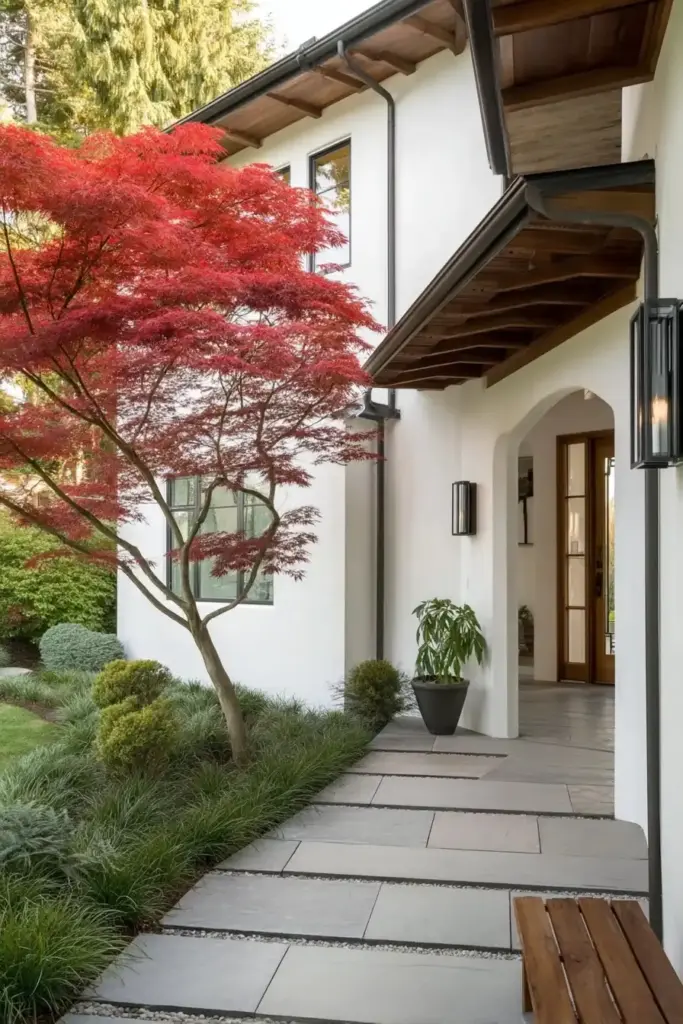
One of the most refined Japanese design garden ideas is to integrate your landscape with the architecture of your home. In a well-planned Japanese maple garden, trees aren’t just decorative—they become an extension of the building itself, softening hard edges, framing views, and enhancing the structure’s overall aesthetic.
Position maples near patios, porches, pillars, or entryways to blur the boundary between indoors and out. Their elegant forms create a visual dialogue with wood, stone, and metal surfaces, especially when carefully lit. Use trees with weeping or vase-shaped growth habits to mirror architectural lines or contrast with rigid features.
Smart Architectural Integration:
- Frame windows or doorways with maples for seasonal “living art.”
- Use container-grown maples on balconies or terraces to add greenery to vertical structures.
- Coordinate leaf color with exterior materials (red maples next to neutral siding, for instance).
When your Japanese maple garden is in harmony with your home’s design, the result is more than just a pretty yard—it becomes an immersive, unified experience of calm, flow, and understated luxury.
🪴 16. Experiment with Container Gardening
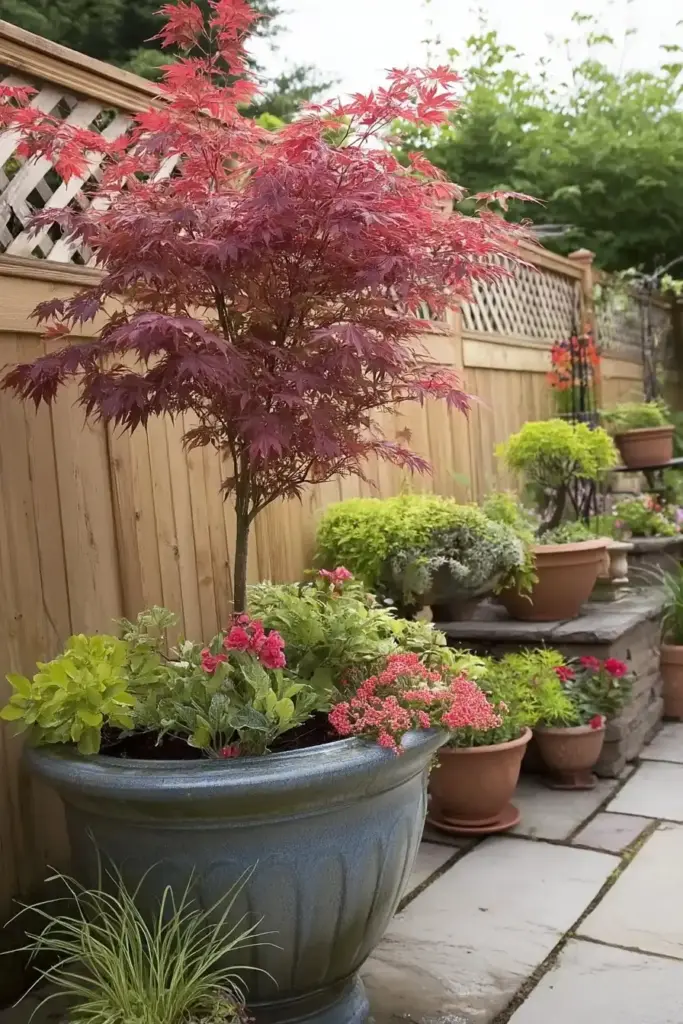
If you’re working with limited space—or just love flexibility—container gardening is a versatile way to enjoy the elegance of a Japanese maple garden. Many compact or dwarf maple varieties thrive in pots, making this one of the most adaptable Japanese design garden ideas, perfect for patios, balconies, and even rooftop retreats.
Select well-draining containers that complement your overall aesthetic—ceramic, concrete, or even traditional wooden planters all work well. Be sure to use high-quality potting soil and monitor moisture levels closely, as potted maples can dry out faster than in-ground ones. Containers also allow you to move your trees with the seasons, optimizing sunlight or protecting them from extreme weather.
Container Gardening Tips:
- Choose slow-growing or dwarf cultivars like Acer palmatum ‘Shaina’ or ‘Mikawa Yatsubusa’.
- Add a plant caddy with wheels for easy repositioning and mobility.
- Group containers of varying heights to create visual layering in small spaces.
Container gardening gives you control and creativity—two essential ingredients for cultivating a personal Japanese maple garden no matter your space. It’s also an excellent way to experiment with different maple varieties before committing to permanent placement.
🌿 17. Create a Dynamic Duo
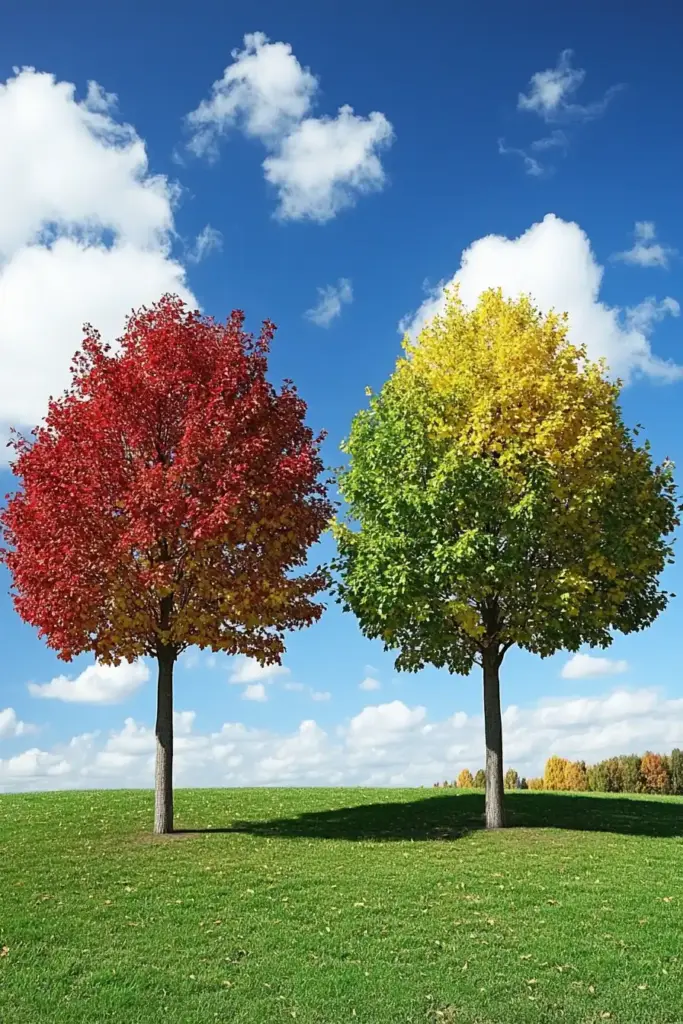
Incorporating multiple Japanese maple varieties is one of the most striking ways to enhance your Japanese maple garden. By planting two distinct cultivars side by side, you introduce contrast, depth, and a sense of curated artistry—hallmarks of timeless Japanese design garden ideas.
Look for maples with complementary but contrasting features: a vibrant red variety next to a lush green, or a weeping laceleaf beside an upright palmatum. The interplay of color, shape, and texture creates a visual rhythm that feels intentional and serene. This “duo planting” technique is especially effective in focal point areas or transitional zones like garden entrances and pathway intersections.
Dynamic Duo Design Suggestions:
- Color contrast: Try Bloodgood (deep burgundy) paired with Viridis (bright green).
- Form contrast: Combine an upright tree with a cascading weeper for sculptural balance.
- Seasonal interest: Select one early-turning and one late-turning maple to extend fall color.
These pairings offer a beautiful conversation between trees—subtle, dynamic, and endlessly evolving. It’s a simple yet impactful strategy to make your Japanese maple garden look custom-designed and seasonally expressive.
🌱 18. Experiment with Bonsai Techniques
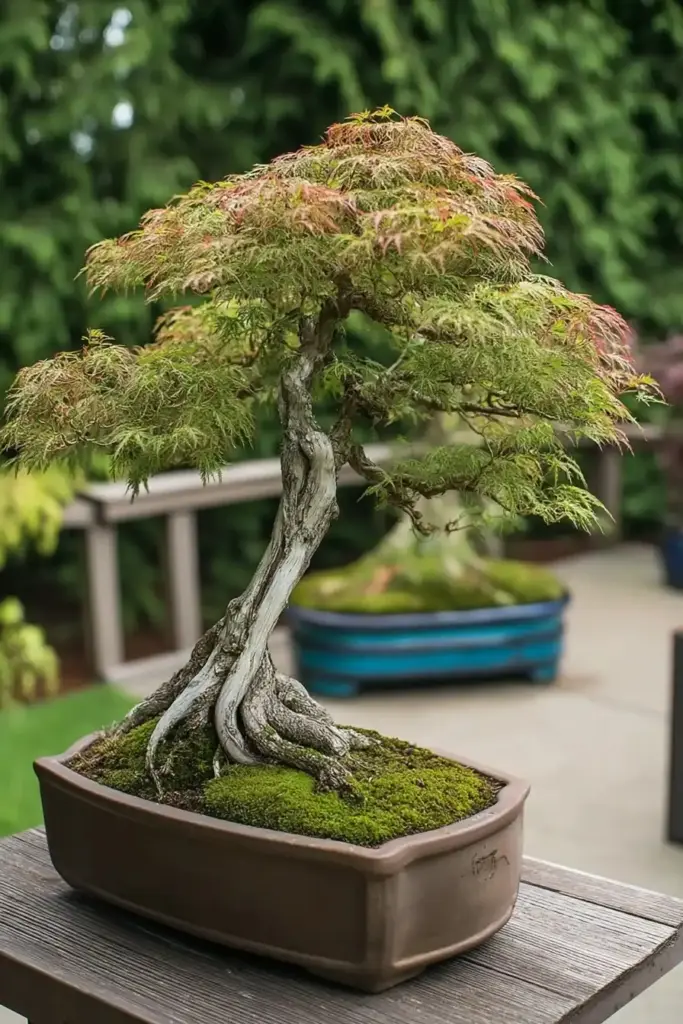
For those who appreciate the artistry and patience of detailed gardening, incorporating bonsai into your Japanese maple garden opens up a whole new layer of beauty. Bonsai—literally meaning “planted in a container”—is one of the most iconic Japanese design garden ideas, emphasizing control, balance, and reverence for nature in miniature form.
Japanese maples are among the most popular trees used for bonsai because of their delicate leaves, colorful foliage, and forgiving growth habits. Even a single bonsai maple, placed on a stone pedestal or wooden platform, can become the focal point of a small space or Zen corner.
Getting Started with Maple Bonsai:
- Choose small-leaf varieties like Acer palmatum ‘Kiyohime’ or ‘Arakawa’ for better proportion and detail.
- Start with a young tree or bonsai starter kit to learn the basics of shaping and pruning.
- Display it purposefully—on a garden table, inside a rock niche, or framed by a meditation area.
Introducing bonsai into your Japanese maple garden adds a meditative, sculptural layer that celebrates patience and craftsmanship. It’s not just gardening—it’s living art that evolves alongside your space and spirit.
💡 Conclusion
A well-planned Japanese maple garden is more than a visual delight—it’s an expression of harmony, tranquility, and artistic intention. Whether you’re layering different maple varieties, crafting an intimate garden nook in a small yard, or experimenting with bonsai, each design choice brings character and calm to your space. These Japanese design garden ideas offer versatile options for any size or style of garden, from modern courtyards to traditional Zen retreats.
By thoughtfully integrating maples with water features and outdoor lighting, architecture, and contrasting foundation plants, you can transform any outdoor area into a peaceful sanctuary that evolves beautifully through the seasons. No matter your space or skill level, Japanese maples offer a timeless way to bring grace, balance, and natural beauty into your garden life.

